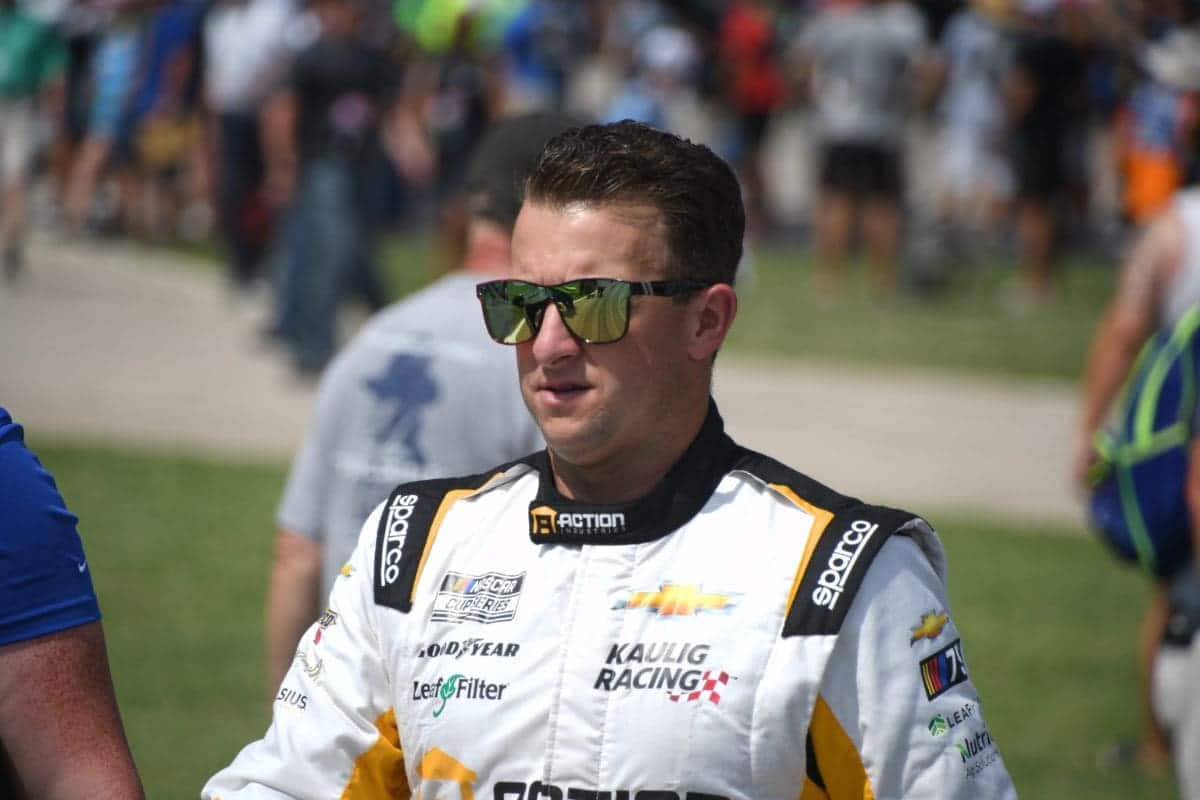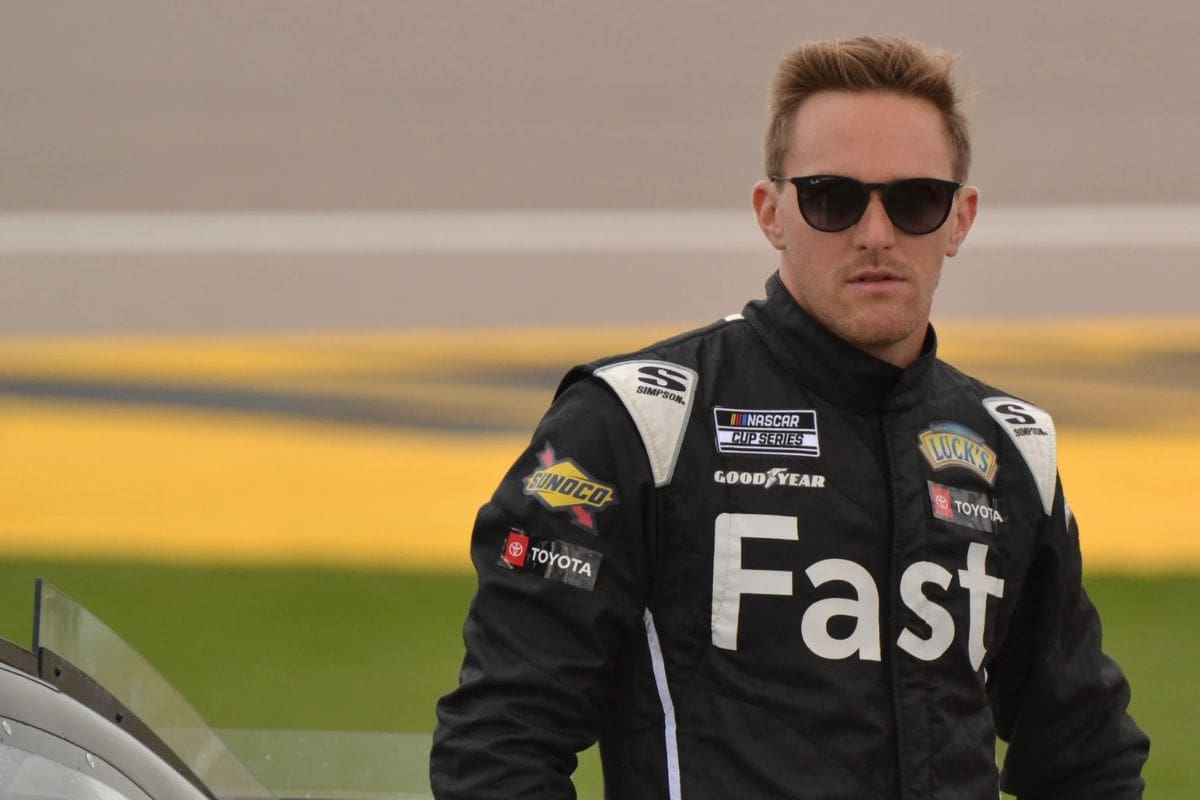AJ Allmendinger and Parker Kligerman Final Lap Collision: The final lap collision between AJ Allmendinger and Parker Kligerman at Daytona race serves as a compelling case study in the intricacies of NASCAR strategy and driver psychology. As Kligerman’s bold maneuver, propelled by a calculated push, collided with Allmendinger’s defensive instincts, the incident not only reshaped the race outcome but also raised critical questions about the balance of aggression and caution in high-pressure situations. This pivotal moment begs a deeper examination of the motivations and reactions from both drivers, and how such dynamics can redefine the narratives of competitive racing.
Key Highlights
- AJ Allmendinger led the race but faced a dramatic final lap collision with Parker Kligerman, resulting in a spin and crash.
- The incident stemmed from aggressive racing tactics, with Kligerman asserting that Allmendinger’s block contributed to the collision.
- Kligerman received momentum from Chandler Smith’s push, complicating the dynamics during the final moments of the race.
- AJ Allmendinger expressed pride in his team’s performance despite frustration over the lost momentum leading to the incident.
- The collision intensified the playoff race atmosphere, impacting both drivers’ standings and future racing strategies.
AJ Allmendinger’s Performance and Frustration
How did AJ Allmendinger transform his recent struggles into a promising performance at Daytona? Entering the NASCAR Xfinity Series race on August 19, Allmendinger was seeking redemption after a season marked by inconsistency and the looming threat of a winless year—a clear contrast to his previous five seasons.
However, at Daytona, he showed not only resilience but also tactical acumen, leading the most laps and finishing strong.
Allmendinger’s ability to navigate the complexities of restrictor plate racing was evident as he adeptly maneuvered within the top five throughout the event. His finishes of third and fourth in the stages emphasized his competitive edge and adaptability.
The collaboration with Parker Kligerman proved pivotal, as their teamwork allowed Allmendinger to maintain a strong position and enhance his chances for victory.
Despite being overshadowed by Justin Allgaier’s stage sweeps, Allmendinger’s performance was a demonstration of his skillful racing and tactical expertise. Leading 35 laps in a 102-lap event highlighted his dominance and determination.
Yet, this promising outing was tinged with frustration, as the specter of missed opportunities loomed over the veteran driver. The culmination of his efforts positioned him for potential victory, but ultimately, it raised questions about what more he could accomplish if he could consistently harness this level of performance.
Incident on the Final Lap
The intense competition at Daytona reached a dramatic climax on the final lap, where a collision between AJ Allmendinger and Parker Kligerman defined the outcome of the race. As they approached Turn 1, Kligerman received a notable push from Chandler Smith, propelling him to plunge below Allmendinger. This maneuver set the stage for a contentious incident that would ignite debate among fans and analysts alike.
The circumstances surrounding the collision remain contentious. On one hand, Kligerman’s aggressive side draft could be interpreted as excessive, potentially triggering the chain of events that led to Allmendinger’s spin. Conversely, some argue that Allmendinger miscalculated his defensive tactics, executing a questionable block that resulted in the contact.
A look at the contact between AJ Allmendinger and Parker Kligerman that brought out the yellow to end the race. #NASCAR pic.twitter.com/FckZTqRYtQ
— NASCAR on NBC (@NASCARonNBC) August 24, 2024
Regardless of the perspective, the outcome was glaringly clear: Allmendinger’s car was sent into a spin, crashing hard into the Turn 1 wall.
As Allmendinger’s vehicle careened back up the track, the race’s atmosphere shifted dramatically, with the caution flag waving and the immediate attention turning to the aftermath of the collision. Kligerman, benefiting from the chaotic circumstance, managed to secure a place in the rankings amid the debris of misfortune that befell his competitor.
Reactions from AJ Allmendinger
AJ Allmendinger’s reaction following the collision highlighted the emotional toll of high-stakes racing. Emerging from the care center, Allmendinger exhibited a mix of relief and frustration, capturing the duality of competitive spirit and the harsh realities of the sport. While he was physically unharmed, the emotional weight of the moment was palpable. His comments reflected a deep appreciation for his team, yet an acknowledgment of the lost opportunity.
- Team Pride: Allmendinger expressed pride in Kaulig Racing, emphasizing the performance of the No. 48 car. “That was a fast Campers Inn RV Chevy,” he noted, underscoring the effort and skill that went into the race.
“I’m just proud of everybody at Kaulig Racing.”
“That was a fast Campers Inn RV Chevy. Had a shot to win and didn’t.” – Allmendinger
- Frustration with Circumstance: Despite his team’s efforts, Allmendinger felt that momentum had slipped away just as they approached the final lap. This sense of lost potential was evident when he stated, “There’s no momentum right now.”
- Deflection of Blame: When questioned about whether he attempted a block, Allmendinger deftly redirected the conversation back to his team’s achievements, saying, “I’m just proud of the team, man.” This demonstrates a commendable team-first mentality, even in moments of personal disappointment.
- Acknowledgment of Competition: His terse remarks served as a reminder of the unpredictable nature of racing, where split-second decisions can lead to dramatic shifts in fortune.
Parker Kligerman’s Perspective
As AJ Allmendinger grappled with the emotional aftermath of the collision, Parker Kligerman offered his own perspective on the events that unfolded during the race. Kligerman provided a candid account, asserting that Allmendinger’s blocking maneuver into Turn 1 was the catalyst for the spin that ultimately took both drivers out of contention.
“White flag through the tri-oval, I pushed the [No.] 16 and the [No.] 20 out,” Kligerman recounted, highlighting the momentum generated by Chandler Smith’s push, which afforded him a noteworthy run.
“The [No. 81 of Chandler Smith] pushed me hard enough that it gave me a monster run at the same time. And I was like, ‘If we clear the bottom, I’m going.’ The [No.] 16 just tried to follow and it was too late.” – Kligerman
Kligerman’s analysis reveals the intricacies of racing dynamics, where split-second decisions can alter outcomes dramatically. His assertion that Allmendinger attempted to follow him too late emphasizes the tightly contested nature of restrictor plate racing, where every move is magnified.
Despite placing responsibility on Allmendinger, Kligerman expressed a sense of regret over the incident, noting the effectiveness of their partnership throughout the race. “We worked great together,” he reflected, highlighting the synergy they had developed in their efforts to challenge the dominant Toyotas.
As the dust settled from this dramatic collision, Kligerman’s insights left fans pondering the delicate balance between aggression and collaboration in the pursuit of victory.
Kligerman’s Focus and Future Outlook
Steering through the aftermath of the Daytona collision, Parker Kligerman’s focus remains steadfast on the playoff picture as he recalibrates his approach. Despite suffering a setback from a spoiler modification penalty earlier in the week, which cost his team 20 driver points and five playoff points, Kligerman demonstrates unyielding determination. He is now determined to utilize his stage points accumulation, shifting his method to remain competitive.
“We got a lot of stage points, which allowed me to be a little bit more aggressive.”
“We came in here after the penalty 16 up, now we leave, I think, 44 up. My strategy was to get great stage points so I could get aggressive in the third stage.” – Kligerman

Kligerman’s outlook can be distilled into four key strategies:
- Aggressive Point Accumulation: The driver capitalized on stage points, allowing him to adopt a more aggressive stance in the race’s final stages.
- Tactical Reassessment: After entering Daytona with a 16-point lead and exiting with a 44-point advantage, Kligerman’s plan is clearly evolving to optimize performance.
- Playoff Focus: With Allmendinger safely positioned in the playoffs, Kligerman must prioritize his own advancement, minimizing distractions from rival antics.
- Long-Term Vision: Kligerman’s mindset is not just about immediate results; he is tactically positioning himself for the remainder of the season, where consistency will prove essential.
As the playoff race intensifies, his tactical adjustments and commitment to performance will be significant in determining his fate in the championship chase. The road ahead may be fraught with challenges, but Kligerman’s resolve to adapt will be an important asset.
News in Brief: AJ Allmendinger and Parker Kligerman Final Lap Collision
The collision between AJ Allmendinger and Parker Kligerman during the final lap at Daytona serves as a poignant reminder of the inherent unpredictability in NASCAR racing. This incident emphasizes the delicate balance between aggressive tactics and the potential for catastrophic misjudgment in high-pressure environments. As discussions regarding racing strategies continue, the event highlights the critical importance of understanding both the risks and rewards that define competitive motorsport, ultimately shaping the narratives of drivers’ careers and the sport itself.
ALSO READ: AJ Allmendinger’s Return to Full-Time Cup Racing in 2025—Kaulig’s Bold Move




